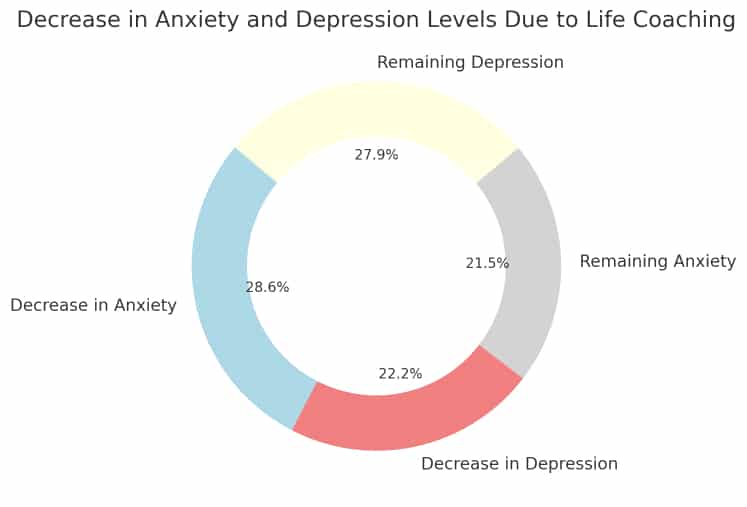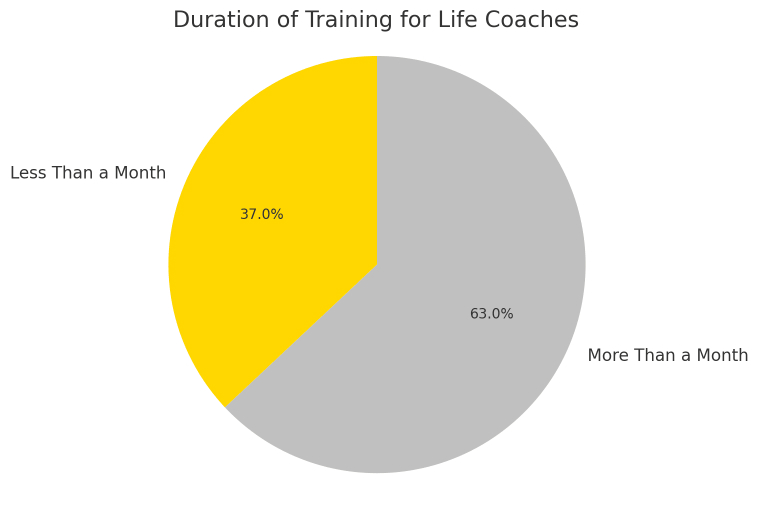In today’s fast-paced world, many individuals often find themselves lost, seeking guidance and direction. This is where life coaches come into play, offering thought-provoking solutions and strategies to help individuals navigate the challenges of life. But have you ever wondered about the statistics behind the life coaching industry? Let’s delve into the extensive and research-backed life coach statistics that paints a picture of this growing profession.
The Rise of Life Coaching
The life coaching industry has witnessed a remarkable growth over the years. Did you know that the worldwide global wellness market is worth a staggering $4.4 trillion and is projected to grow annually by 9.9%? Such figures are not just mere numbers, but are indicative of the increasing trust people are placing in life coaches. This growth is backed by various factors, including the rise of the internet, changing societal patterns, and the evolving role of women in the workforce. Whether you are starting a coaching business or have been in the business for a while, these life coach statistics are a valuable resource.
Key Life Coach Statistics
1. In 2022, the U.S. life coaching market was valued at approximately $1.469 billion and is projected to expand at a compound annual growth rate (CAGR) of 4.85% from 2023 to 2030.
The U.S. market is one of the fastest-growing segments in the industry, reflecting the increasing acceptance and utilization of life coaching services. This figure highlights the robust demand for personal development and the growing recognition of coaching’s effectiveness. The value may reflect a shift towards prioritizing mental health and personal growth in society.
2. Life coaching can lead to a 57.1% decrease in anxiety levels and a 44.3% decrease in depression levels.
These statistics suggest significant mental health benefits associated with life coaching. It indicates that life coaching can be a powerful tool for improving psychological well-being, possibly due to its personalized and goal-oriented approach.

3. Life coaching boasts an 80% success rate among clients.
High client satisfaction and effectiveness of coaching methods are implied here. This rate may be attributed to the tailored strategies life coaches use to address individual client needs.
4. The revenue forecast for life coaches in 2030 is $2.1 billion in the U.S.
This robust projection indicates a promising future for the life coaching industry in the United States. With an estimated revenue of $2.1 billion by 2030, it showcases the sector’s potential for substantial growth. This suggests that there is a growing demand for life coaching services, likely driven by individuals’ increasing recognition of the benefits of personal development and self-improvement.
5. About 88% of participants experienced “significant positive change” after undergoing life coaching.
The fact that 88% of clients undergoing life coaching report positive changes in their lives underscores the efficacy of this profession. This high success rate highlights the valuable impact that life coaches have in helping individuals achieve their personal and professional goals. It also signifies that life coaching is a worthwhile investment for those seeking personal growth and transformation.
6. Over 75% of life coaching clients are female, highlighting the industry’s appeal to a diverse audience.
The statistic indicating that over 75% of life coaching clients are female reflects the broad appeal of life coaching services among women. This suggests that women are proactively seeking out life coaching as a means to empower themselves, whether it be for personal development or career advancement. It could also indicate a unique opportunity for life coaches to tailor their services to better cater to the needs and aspirations of their predominantly female clientele.
7. The average life coach earns $44,090 a year, with some earning as much as $97,000 a year.
This salary range reflects the potential earning power in the life coaching industry, influenced by factors like experience, specialization, and location. Higher earnings are typically associated with more experienced coaches or those in high-demand specializations. The variability also indicates the diverse nature of the field, accommodating coaches with different levels of expertise and client bases.
8. In 2023, the average hourly pay for a Life Coach is around $40.37, with a range extending from $17 to $186
The significant variation in hourly rates for life coaches suggests a broad spectrum of expertise and experience levels within the profession. Coaches with specialized skills, high demand, or extensive experience can command higher rates. This range also indicates the accessibility of life coaching services to a wide range of clients with different financial capabilities.
9. Searching for “life coach” in Google, yields 1.5 billion results.
The staggering number of search results for “life coach” underscores the widespread public interest and awareness of life coaching as a profession and personal development tool. This statistic reflects the growing curiosity and need for life coaching services globally. It also suggests the widespread availability and diversity of coaching services and resources online.
10. Half of American employees would like to see coaching as a benefit.
This statistic reveals a growing recognition of the value of personal development in the workplace, with employees seeing coaching as a desirable job benefit. It indicates a shift in workplace culture towards supporting employee growth and well-being. This trend also suggests that organizations are increasingly considering life coaching as a part of their employee development programs.
11. 60% of Americans want life coaching, while 80% of those people never had it offered to them.
The discrepancy between the high percentage of people wanting life coaching and the lower rate of those offered it highlights a significant untapped market. This gap suggests potential growth opportunities for the life coaching industry. It also indicates a need for greater awareness and accessibility of coaching services to meet this latent demand.
12. The life coaching sector stands as the world’s second most rapidly expanding industry, boasting an impressive annual growth rate of 6.7%.
The life coaching industry’s rapid growth rate demonstrates its dynamic nature and increasing relevance in today’s fast-paced world. This growth is driven by the rising demand for personal and professional development. The industry’s expansion is a response to the evolving challenges and complexities of modern life, where more people seek guidance and support.
13. Most coaches are in the Generation X age bracket, meaning they are born between 165 and 1981.
The prevalence of Generation X individuals in life coaching might be attributed to their life experiences and accumulated wisdom, which are valuable in guiding others. This generation, having experienced significant cultural and technological changes, can offer a blend of traditional and modern perspectives. Their age demographic suggests a maturity and depth of understanding that resonates with a broad client base.
14. 99% of coaches have enjoyed some sort of training, 85% of this group had training from an accredited organization.
This high percentage of trained life coaches, especially those from accredited organizations, reflects the industry’s commitment to professionalism and quality. It underscores the importance of formal training and certification in establishing credibility and effectiveness as a coach. The emphasis on accreditation also helps maintain high standards within the profession and ensures a consistent level of service to clients.

15. A typical coaching client is between 35 and 44 years old.
This age range for typical coaching clients suggests that mid-life is a pivotal time for many individuals seeking personal or professional growth. People in this age group often face significant life transitions or career advancements, driving the need for coaching. This demographic may also have more disposable income to invest in personal development services like life coaching.
16. 55% of life coaches have a bachelors degree.
Over half of life coaches having a bachelor’s degree indicates a high level of formal education within the profession. This educational background provides a foundation of knowledge and critical thinking skills beneficial in coaching. The prevalence of bachelor’s degrees also reflects the profession’s leaning towards well-rounded and educated individuals who can offer diverse insights and perspectives.
17. The most common major for life coaches is Psychology.
The prevalence of psychology majors among life coaches aligns well with the profession, as understanding human behavior and motivation is central to effective coaching. This educational background equips coaches with theoretical knowledge and practical skills essential for facilitating personal growth and change. It also indicates the depth of understanding required to address complex emotional and psychological client needs.
18. 6% of life coaches have a high school diploma as highest enjoyed education.
The presence of life coaches with only a high school diploma suggests that while formal education is common, it’s not the sole pathway to becoming a coach. This statistic highlights the inclusivity of the field, valuing experience and innate coaching skills alongside formal education. It also emphasizes that life coaching is accessible as a career to a wide range of individuals with varying educational backgrounds.
19. 21% of life coaches have a master’s degree.
The significant proportion of life coaches with a master’s degree indicates a level of specialization and advanced knowledge in the field. Coaches with master’s degrees may focus on more complex areas of coaching or research-driven approaches. This level of education also reflects the profession’s trend towards higher academic qualifications, enhancing the field’s credibility and depth.
20. Having either a master’s or a bachelors degree earns life coaches the most, both averaging at $45k.
The similar average income for life coaches with a bachelor’s or master’s degree suggests that while higher education is valued, experience and other factors also play crucial roles in income potential. This parity indicates that the life coaching industry values practical skills and experience as much as formal education. It also reflects the diverse routes through which one can achieve success in this field.
21. Only having a high school diploma earns life coaches the least, at just under $39k.
Life coaches with only a high school diploma earning less on average highlights the perceived value of higher education in the field. This disparity suggests that while entry into the profession is possible without advanced degrees, higher education may offer better income opportunities. It also reflects the market’s general tendency to correlate educational attainment with professional expertise and compensation.
22. 15% of life coaches work in the education sector.
The involvement of life coaches in the education sector reflects the crossover and synergy between educational methodologies and life coaching techniques. This statistic indicates that life coaches are playing a role in educational settings, possibly offering support to educators or students. It also suggests the growing recognition of the importance of personal development skills in the educational sphere.
23. 10% of life coaches work in the government sector.
Life coaches working in the government sector demonstrate the field’s expanding reach into various professional areas. This presence in the public sector indicates a recognition of the value of life coaching for employee development and well-being. It also suggests that governmental organizations are beginning to see the benefits of incorporating life coaching into their employee support programs.
24. Life coaching offers a return on investment (ROI) of 344%.
The high return on investment for life coaching signifies both tangible (like career advancement) and intangible benefits (such as improved well-being). This impressive ROI indicates the effectiveness of life coaching in delivering measurable results for clients. It also highlights the value clients place on the outcomes they achieve through coaching, often surpassing their initial investment.
25. As of 2020, there were around 71,000 professional life coaches worldwide.
This figure demonstrates the global presence and acceptance of life coaching as a legitimate and sought-after profession. The international spread of life coaches reflects the universal appeal and applicability of coaching principles across different cultures and countries. This number also indicates the profession’s substantial growth and its established role in the global personal development landscape.
26. In America, 59% of life coaches speak Spanish as their second language.
The linguistic diversity, particularly the prevalence of Spanish-speaking life coaches in America, points to the inclusive and multicultural nature of the profession. This statistic suggests that life coaching is accessible to a broader audience, catering to a diverse client base with varying linguistic needs. It also reflects the growing demand for bilingual coaches in a multilingual society.
27. California is the state with the most life coaches, Alaska having the least.
The concentration of life coaches in California versus Alaska likely reflects differences in population density, cultural factors, and the economic environment. California’s status as a hub for innovation, personal development, and higher income levels may contribute to a higher demand for life coaching services. In contrast, Alaska’s lower population and different lifestyle might result in less demand or fewer opportunities for life coaches.
28. The city with the most life coaches in America is New York, NY.
The high number of life coaches in New York City underscores the demand for personal development services in urban, densely populated, and high-stress environments. New York’s diverse and dynamic population, along with its role as a business and cultural center, creates a fertile ground for life coaching. This statistic reflects the city’s openness to self-improvement and the importance of coaching in managing the complexities of urban life.
29. 37% of life coaches train less than a month.
This statistic about the duration of training for life coaches suggests varied depths and approaches in their preparation. It indicates that some coaching certifications can be obtained relatively quickly, although this might not equate to comprehensive training. This variability in training duration also reflects the lack of uniform standards in the life coaching industry, leading to a wide range of competencies among coaches.

30. A majority, 60%, of life coaches provide their services online.
The significant portion of life coaches offering services online reflects the field’s adaptability and the impact of technology. This trend has been accelerated by the COVID-19 pandemic, which necessitated a shift to digital platforms. Online coaching increases accessibility for clients, allowing them to connect with coaches regardless of geographical barriers.
31. A significant 43% of respondents of a ICF study have previously engaged with a coach.
This statistic from an International Coach Federation (ICF) study demonstrates the considerable reach and impact of life coaching on individuals. The engagement rate indicates a high level of acceptance and satisfaction with coaching services among those who have experienced them. It also suggests that once individuals engage with a life coach, they often find the experience beneficial, which can encourage others to seek similar services.
32. Although growing overall, Covid-19 had a negative impact on life coaching. In 2021, 43% of coaches said they lost clients since 2020.
This statistic underscores the vulnerability of the life coaching industry to global crises like the pandemic. The loss of clients could be attributed to economic downturns, shifting priorities, or logistical challenges, reflecting how external factors can significantly impact the demand for life coaching services.
33. 74% of life coaches increased the use of audio and video platforms since 2020.
This highlights the industry’s resilience and adaptability. Life coaches rapidly transitioned to digital platforms in response to the pandemic, maintaining client relationships and expanding their reach through technology, which has likely altered the landscape of life coaching permanently.
34. Obese participants of a 2014 study demonstrated significant improvements in motivation and confidence after receiving life coaching.
This finding emphasizes the effectiveness of life coaching in areas beyond traditional personal development, extending to health and wellness. It suggests that life coaching can play a crucial role in addressing challenges like obesity by boosting motivation and self-confidence, key factors in lifestyle changes.
35. Of those who haven’t yet experienced life coaching, 22% expressed they would seek guidance in the future.
This percentage points to a substantial untapped market for life coaching. With nearly a quarter of the population open to seeking life coaching in the future, there’s significant potential for growth in the industry, highlighting the ongoing need for personal development and support services.
Why the Surge in Demand For Life Coaches?
Several reasons contribute to the booming life coach industry:
- Awareness: The benefits of life coaching are becoming more widely recognized, leading to increased demand.
- Internet Growth: The digital age has made it easier for individuals to seek out and connect with a life coach.
- Millennial Influence: The younger generation is more open to seeking guidance and mentorship to improve their lives.
- Workforce Evolution: The dynamic nature of today’s jobs has led many to seek coaching to achieve a better work-life balance.
- Globalization: With the world becoming a global village, a life coach can now cater to clients from different parts of the world.

What determines How much A Life Coach Earns?
Because most life coaches are freelancers, they can choose either to work full time or part-time. This is what makes the largest difference. The amount you charge is a big deciding factor as to how much a life coach can earn. Life coaches with certification charge more than those without.
According to the life coach statistics, the background of a life coach matters. Coming from another health related job can mean you earn more than someone who is deciding to become a life coach without previous experience in wellness and health.
The Design Aspect
For coaches and influencers looking to establish their own business and website, understanding the design elements that resonate with their target audience is crucial. A well-designed website attracts potential clients and establishes the coach’s authority in the field. Incorporating elements like testimonials, success stories, and interactive sessions can make the website more engaging and trustworthy.
Conclusion
The life coaching industry, backed by scientific research and worldwide professionals, offers a promising future for both coaches and those seeking their services. As the industry continues to grow, it’s essential for aspiring coaches and influencers to stay updated with the latest trends and statistics. By doing so, they can position themselves effectively in the market and help countless individuals achieve their personal and professional goals.
FAQ
- How many professional coaches were there in North America in 2020?
In 2020, North America had over 26,000 professional coaches actively serving clients. - How much does a life coach earn?
A life coach earns an average of $44k a year, although some life coaches earn upwards of $97k a year. - What is the hourly rate for a life coach?
Hourly rates for a life coach can vary between $50 and $200. - What is life coaching?
A collaborative process where a coach helps clients achieve personal goals, overcome challenges, and make positive life changes. - What areas do life coaches focus on?
Personal growth, relationships, career transitions, work-life balance, and stress management. - How is life coaching different from therapy?
Life coaching focuses on the present and future, guiding clients towards a fulfilling life, while therapy often delves into past traumas.
Sources
International Coaching Federation (ICF)
https://www.zippia.com/life-coach-jobs
https://www.grandviewresearch.com/industry-analysis/us-life-coaching-market-report
https://www.payscale.com/research/US/Job=Life_Coach/Hourly_Rate
